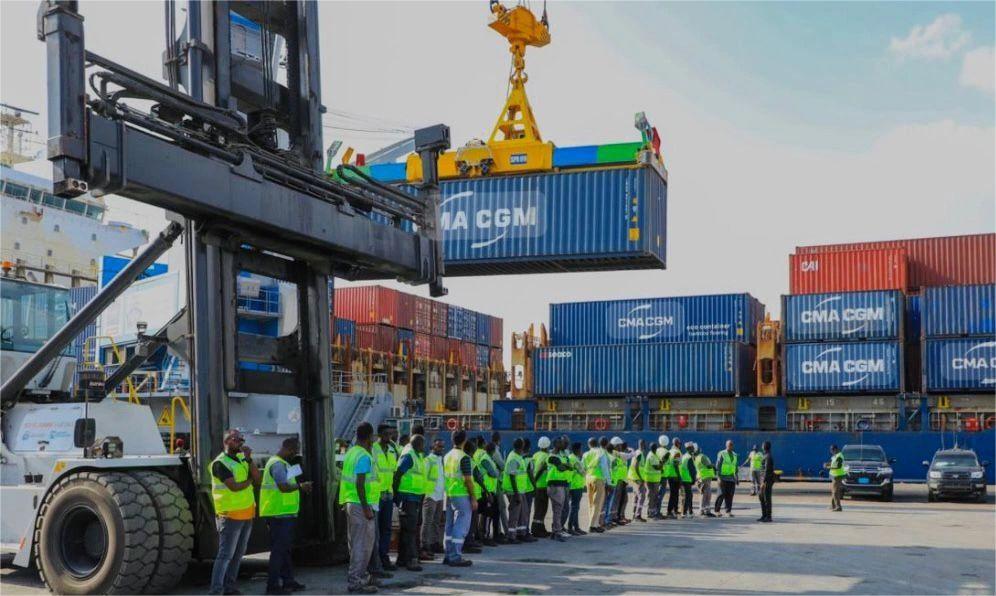Mogadishu ranked 4th in Africa, 163rd globally and first in East Africa, outpacing regional peers Dar es Salaam, Djibouti and Mombasa.
by Blue Africa News
Somalia’s Mogadishu port was ranked the most efficient gateway in East Africa in the 2024 Container Port Performance Index (CPPI), recently published by the World Bank and S&P Global Market Intelligence, placing it ahead of Tanzania’s Dar es Salaam, Djibouti and Kenya’s Port of Mombasa, prompting a regional official to say that Mombasa “can do better,” even though the port has seen considerable improvement.
CPPI evaluated over 400 global ports including over 40 in Africa, with the final ranking being based on among other perimeters, the total time vessels spend in a given port – from arrival at anchorage to departure after loading or unloading cargo.
Mogadishu ranked 4th in Africa behind Port Said (Egypt), Tanger Med (Morocco) and Senegal’s Dakar; 163rd globally and first in East Africa, outpacing regional peers Dar es Salaam, Djibouti and Mombasa.
Dar es Salaam and Djibouti were ranked 31st and 32nd in Africa and 360th and 364th globally respectively, while Mombasa came a distant 35th in Africa and 375th globally.
“This achievement demonstrates that a port can compete effectively at regional and global levels even without the largest infrastructure investments,” said Ambassador Mohamed Ali Nur, Director General of the Mogadishu Port Authority (MPA), in a statement.
“We are proud to offer shipping lines a reliable gateway and contribute to Somalia’s growing role in regional and international trade,” added the former Somalia Ambassador to Kenya.
In 2023, Berbera port in Somaliland was ranked the best in East Africa, occupying position 106 globally, while Mombasa (328) Dar es Salaam (367) and Djibouti (379) followed in that order. In 2021, Mombasa performed even better, with a 296th global rank.
Reacting to the 2024 report, Agayo Ogambi, Chief Executive Officer (CEO) of the Shippers Council of Eastern Africa (SCEA) told Blue Africa News in a phone interview that the port of Mombasa “can do better,” but added that it is not as “bad as that World Bank report wants to say.”
In 2024, the port of Mombasa, he said, handled a record over 2 million twenty-foot equivalent units (TEUs) of cargo, most likely stretching its infrastructure, and occasioning the ‘poor’ ranking due to an increased cargo dwell time, which Ogambi noted, currently stands at 5 days.
“But we also appreciate that the port throughput has continued to increase, and this calls for better focus and better planning to ensure that we have adequate infrastructure before the supply,” he said, adding that Mombasa’s target for 2025 is to handle 2.3 million TEUs.
“Our position is we just need to improve our port performance. And this far, we are aware that the government has instituted measures of procuring additional equipment and improving the infrastructure, including additional baths,” added Ogambi, who doubles up as the chairman of the Mombasa port community charter.
The ranking, he said portrays the port badly, “But people using the port and people who have used the other ports are well-placed to appreciate that the Mombasa port still serves, not optimally, but reasonably fairly well.”
According to the CEO, technological advancement is being embraced at African ports – more so Mombasa to increase efficiency, which will in the long run lead to better rankings in the future.
“There’s the use of scanners to assist in enhancing the verification. And they’re also in the process of securing some terminal operating systems just to enhance the planning and management of the terminal,” he noted.
Meanwhile, maritime trade volume is expected to expand by 0.5 per cent in 2025, with containerized trade increasing by 1.4 per cent, according to the United Nations Conference on Trade and Development (UNCTAD) 2025 review of maritime transport report titled “staying the course in turbulent waters” released recently.
“Over the medium term (2026–2030), total seaborne trade is projected to grow at an average annual rate of 2 per cent, while containerized trade is forecast to rise by 2.3 per cent,” the report says.
The report further notes that countries with the logistics capacity to manage diversified sourcing – efficiently handling goods from multiple origins, will be better positioned to attract trade and investment within reconfigured supply chains.
Oliver Ochieng, Blue Africa News

